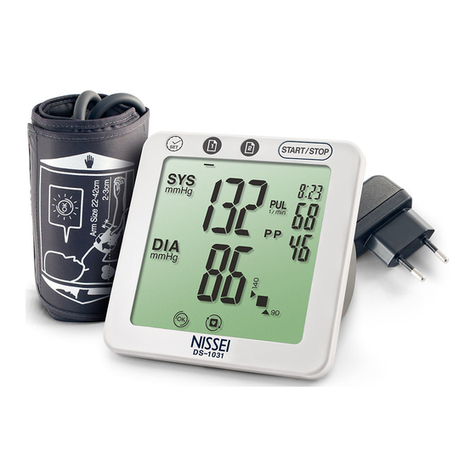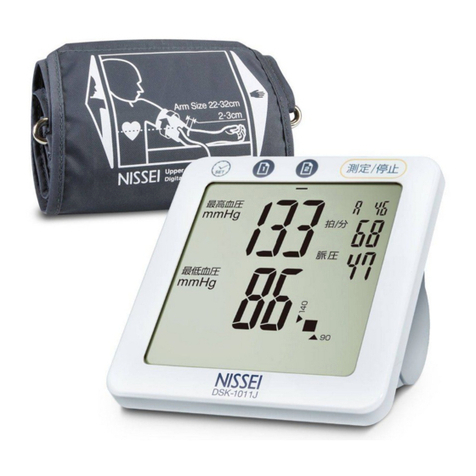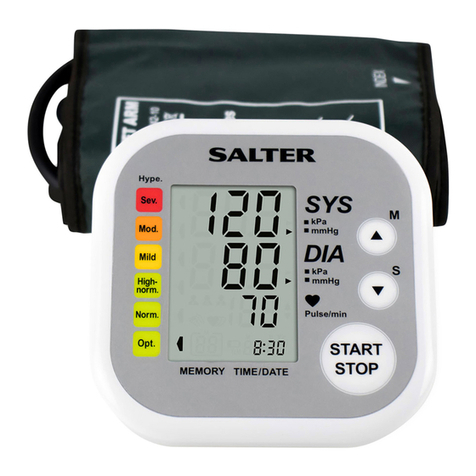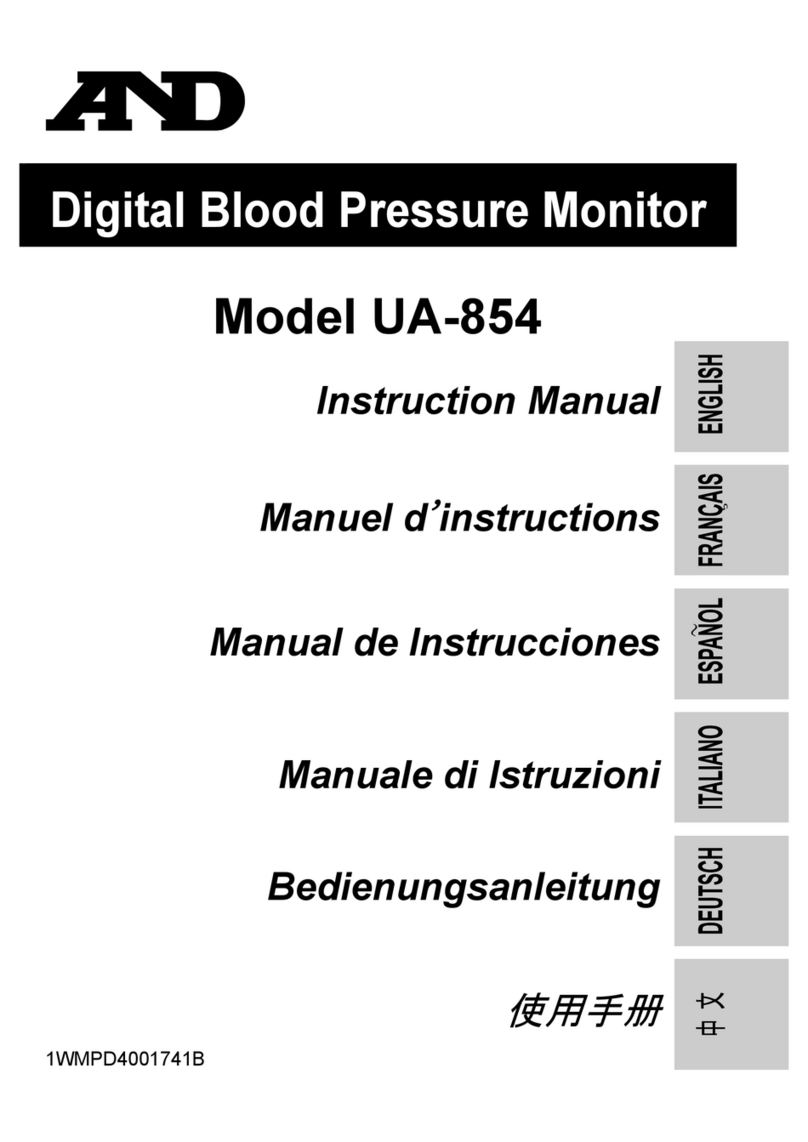Nissei DS-1011 User manual

JAPAN
DS-1011
Прибор для измерения артериального
давления и частоты пульса цифровой DS
Руководство по эксплуатации
RUS
Вимірювач артеріального тиску та частоти серцевих
скорочень (Digital blood pressure monitor DS-1011)
Інструкція з експлуатації
UKR
Kүретамырдың қан қысымы мен тамырдың соғу
жиілігін өлшеуге арналған сандық DS аспабы
Пайдалану жөніндегі басшылық құжат
KAZ
Digital Blood Pressure Monitor
Instruction Manual
ENG

52
ENG
This manual is intended to assist you in the safe and efficient operation of BLOOD PRESSURE
MONITOR DS-1011. The product must be used in accordance with the procedures contained in this
manual and must not be used for purposes other than those described herein. It is important to read
and understand the entire manual. In particular, please read carefully and become familiar with the
section entitled “TIPS ON TAKING YOUR BLOOD PRESSURE”.
PART NAMES AND PRODUCT COMPONENTS
1. Cuff
2. Power Adapter
3. Batteries
4. Monitor
A. Air plug
B. Battery Compartment
C. AC Connector
D.
“Set” Key
E. Memory Key
F. Memory Key
G. “Start/Stop”Key
H. Display
I. Air connector
K. Air hose

53
ENG
GENERAL INFORMATION
Indications for use
The device is designed to measure systolic and diastolic blood pressure and heart rate reading in patients
aged 13 years and older. This device should not be used for neonate or infant. Consult your doctor for
blood pressure measurement in children or person in pregnancy or under pre-eclamptic condition. The
device is recommended for use in patients with unstable (nonpermanent) blood pressure or hypertension
at home as a supplement to medical surveillance. The cuff is suitable for a upper arm with a circumference
of about 22 - 32 cm. Blood pressure is measured in the range from 50 to 250 mmHg for systolic and 40 to
180 mmHg for diastolic, in the range from 40 to 160 heartbeats per minute.
Method Of Measurement
This product employs the oscillometric method for measurement of blood pressure and pulse rate. The
cuff is connected to the main unit and wrapped around the arm. Circuits within the cuff sense the small
oscillations in pressure against the cuff produced by the expansion and contraction of the arteries in the
arm in response to each heart beat. The amplitude of each pressure waves is measured, converted to
millimeters of mercury, and displayed on the LCD as a digital value.
Used new NISSEI Technologies
Measurement on Inflation – is a technology that makes it possible to define the pressure in
the course of the cuff inflation.
Irregular Pulse Rhythm indicator – displays when the pulse rhythm detected during
measurement was irregular. Pulse rhythm can be disturbed from talking, moving or arrhythmias.
Personal Mode – the inflation is adjusted based on the latest three readings.
Touch Control – touch-sensor operation.
Noise Interference Detection – indicator informs on the occurrence of noises that can affect
the measurement result.
Pulse Pressure Display – calculates and displays pulse pressure. Pulse pressure is value subtract
diastolic value from systolic value and therefore pulse pressure tends to increase with age.
ATTENTION! Do not use cuffs other than the original cuff included with this product.
COMPLETE SET
1. Main body – 1 pcs.
2. Cuff – 1 pcs.
3. Battery – 4 pcs.
4. AC Adapter – 1 pcs.
5. Carrying bag – 1 pcs.
6. Instruction manual – 1 pcs.

54
ENG
7. Warranty card – 1 pcs.
8. Packing – 1 pcs.
TIPS ON TAKING YOUR BLOOD PRESSURE
1. If treated with hemodialysis or anticoagulants, antiplatelets or steroids, refer to your doctor about
the blood pressure measurement.
2. Malfunctions are possible when the device is used near working mobile phones, microwave ovens
and other equipment generating electromagnetic radiation.
3. For correct measurement it is necessary to know that the BLOOD PRESSURE IS SUBJECT TO SHARP
FLUCTUATIONS EVEN IN SHORT TIME INTERVALS. The blood pressure level depends on many factors.
It is commonly lower in summer and higher in winter. Blood pressure varies along with atmospheric
pressure and depends on the physical exertion, emotional excitability, stress and diet. Medical drugs,
alcohol and smoking exert great influence as well. Occasionally, measurements in the clinic cause an
increase in pressure values. Therefore, blood pressure measured at home is often different from that
measured in the clinic. Since blood pressure increases at low temperatures, measurements should be
made at room temperature (about 20°C). If the device was stored at low or high temperature outside
the operational temperature range prior to using, it should be kept for at least 2 hours at room
temperature. Otherwise the measurement result can be erroneous. During the day, the difference in
the readings in healthy people may attain 30-50 mm Hg for systolic (upper) pressure and up to 10
mm Hg for diastolic (lower) pressure. Dependence of blood pressure on various factors is individual
for each person. Therefore it is recommended to keep a special recording of blood pressure
readings. ONLY A DOCTOR MAY ANALYZE TRENDS IN CHANGING YOUR BLOOD PRESSURE BASED ON
CORRESPONDING RECORDINGS.
4 In case of cardiovascular diseases and a number of other diseases that require the blood pressure
monitoring, measurements should be carried out in the hours specified by a doctor. REMEMBER
THAT THE DIAGNOSTICS AND ANY TREATMENT OF ARTERIAL HYPERTENSION SHOULD BE CARRIED
OUT ONLY BY A DOCTOR BASED ON BLOOD PRESSURE READINGS OBTAINED BY A DOCTOR. MEDICAL
DRUG ADMINISTRATION OR CHANGE OF DOSAGES SHOULD BE MADE ONLY BY PRESCRIPTION OF AN
ATTENDING DOCTOR.
Fig.1

55
ENG
5 In case of disorders such as deep vascular sclerosis, weak pulse wave and break in rhythm of heart
contractions, the correct blood pressure measurement can be complicated. IN THIS CASE, A DOCTOR
SHALL PROVIDE RECOMMENDATIONS IN RELATION TO USE OF THIS DEVICE.
6 KEEP QUIET DURING THE MEASUREMENT TO OBTAIN THE CORRECT BLOOD PRESSURE READING
WHEN USING THE ELECTRONIC DEVICE. The blood pressure measurement should be carried out in a
quiet comfortable atmosphere at room temperature. Exclude meal an hour before the measurement, and
exclude smoking, soft drinks, and alcohol 1.5-2 hours before the measurement.
7 Accuracy of the blood pressure measurement depends on matching the device cuff and size of your
arm. THE CUFF SHOULD NOT BE TOO SMALL OR TOO BIG.
8 Repeated measurements are carried out at 5-minute intervals to recover the blood circulation.
However, persons suffering from severe atherosclerosis, due to a significant loss of elasticity of blood
vessels, need longer intervals between measurements (10-15 minutes).
This also concerns patients suffering from long-term diabetes. For more accurate determination of blood
pressure it is recommended to carry out a series of three consecutive measurements and to calculate the
average value of measurement results.
9 Do not use this device in an explosive environment such as near flammable anesthetics or inside
oxygen chamber.
10 The system may fail to yield specified measurement accuracy if operated or stored in temperature or
humidity conditions outside the limits stated in the specifications section of this manual.
11 Do not use cuffs or accessories other than those specified by the manufacturer. Otherwise, correct
measurement readings cannot be obtained.
12 Do not apply the cuff over wounded arm, arm under an intravascular access or therapy or an arterio-
venous shunt, or arm on the side of a mastectomy or lymph node clearance. Otherwise injury may be
resulted.
13 Make sure that inflation of the cuff is not causing prolonged impairment of blood circulation. Also,
be cautious about temporary loss of the functions of any other medical equipment if any monitoring
equipment is used on the same limb with the blood pressure measuring cuff.
14 To avoid harmful injury due to interfered blood flow from cuff inflation, make sure that AIR HOSE is not
kinking before measurement. Otherwise, cuff inflation may not be conducted properly and prolonged.
15 Do not take out batteries or unplug the AC adaptor when the device is turned on. Make sure to switch
off the device before removing batteries or AC adaptor.
16 Do not touch the output plug of AC adaptor during measurement.
17 Do not inflate the cuff when it is not wrapped around your arm.
18 Do not apply the cuff on the limb which the intravenous drip infusion is implemented.

56
ENG
Fig.2 Fig.3
BATTERY INSTALLATION
1.
Open the battery compartment cover (fig.2).
2. Install four“AA”type batteries into the compartment.
Make sure that the polarities correspond to the (+) and (–)
marks inside the battery compartment (fig.3).
Batteries can be easily installed or removed as their (-) ends
are pushed against the spring.
You may use nickel hydride rechargeable batteries. These
batteries can not be charged with this product. Use the
designated battery charger.
3. Close the battery compartment cover.
Do not force the battery cover into position.
Battery symbol will flash when
battery power is low.
Measurement can not be made while the
symbol is displayed. Replace the batteries.
All four batteries need to be replaced with
new ones; do not mix new and old batteries
or diff erent batteries.
The symbol might appear only during
measurement although you can review
readings in memory. This is because more
battery power is required for conducting a
measurement, e.g. inflating the cuff , than
displaying the readings in memory. Please
have the batteries replaced. The enclosed
batteries are for monitoring, and their life may
be shorter than that of commercial batteries.
The used electrical and electronic
products are not household waste.
Follow your national/local recycling
rules to dispose of them properly.
Operation With AC Adaptor
AC Adapter socket is located at the side of the device.
Connect the AC Adapter jack to the device firstly and after
supply AC Adapter plug into the power outlet, press «START /
STOP».To switch off the device after finishing the measurement
press «START / STOP», unplug the AC Adapter from the power
outlet and disconnect AC Adapter from the device
.
WARNING!
If you will switch off AC Adapter
without batteries in the device all
information stored in memory (results of
measurements, date and time) will erased.
If you want to save this information, do
not remove batteries from the device
when using the AC Adapter.
ADJUST DATE AND TIME AND ACTIVATE THE CLOCK
Date and time can be set after installing the batteries.
Set the time guarantees the preservation of the measurement results with the correct date and time.
There is a possibility of measurement of pressure and pulse rate without setting date and time.

57
ENG
Press “SET” KEY until “2011” starts flashing.
Clock is set in the order of year, month, day, hour and minute.
The flashing number increases with and decreases with .The number will be fast-forwarded if
you keep your finger on the key. Pressing “SET” will fix the number and the next article will flash.
Pressing “START/STOP” will terminate the setting.
IMPORTANT! If the date and time have been set, current time will be shown on the display when the
device is turned off.
CORRECT MEASURING POSTURE
Sit down at the table with your back
supported and feet flat on the floor so that
during the blood pressure measurement your
forearm and hand are on its surface. Make
sure that the place where the cuff is put on
the upper arm is about the same level as the
heart and the forearm and hand freely lie on
the table and does not move(fig.4).
Pressure measurement while lying. Place the
cuff at heart level, using a case or a folded
towel (fig.6).
The results of measurements can vary slightly depending on the posture during the measurement. If the
cuff is below (above) in relation to the heart, the measurements will be overstated (understated).
WRAPPING THE CUFF
Fig.7
1 Put the cuff on your left arm with AIR HOSE positioned toward your arm.
(fig.7). You may use your right upper arm for measurement (the results of
measurements can slightly).
Fig.8
2
Attach the cuff with hook and loop fastener with the lower edge of the
cuff approximately 2 to 3 cm above the inner elbow. Adjust the position of
the cuff so that AIR HOSE is over the inner part of your arm over the brachial
artery
(fig.8)
.
Fig.4 Fig.5 Fig.6

58
ENG
Fig.9
3 Press the surface of the cuff to make sure that the hook & loop fastens
securely (fig.9). If the cuff is wrapped tightly or loosely, inaccurate blood
pressure readings may result.
Fig.10
4 If the arm has taper form, it is recommended to put the cuff on “spiral
way”, as shown in the figure (fig. 10).
Fig.11
5 If you are wearing a shirt that might restrict circulation in your upper
arm or you roll your sleeve up over the upper arm, the blood flow will be
restricted, preventing accurate measurement (fig.11).
PROCEDURE FOR THE MEASUREMENT
IMPORTANT! The device has sensor keys and clicking is a slight touch of a finger.
Moisture, dirt and other objects between the finger and panel of the device can affect the ability to
respond to the touching keys.
1. Insert AIR PLUG into AIR CONNECTOR before starting a blood pressure
measurement.
Take deep breaths and relax. Do not move, chat or strain your arm or arm during
measurement.
2. Press “START/STOP”. Air is exhausted from the cuff (fig.12).
3. Automatic inflation starts (fig.13).
4. Inflation stops when the pressure, that is, the displayed value, reaches the
designated value.
Noise Interference Detection
Blood pressure value taken while moving cannot be said to be the
correct value because body movement can affect blood pressure.
This product analyzes pulse wave and displays
« » when body motion
is detected. Symbol « »
indicates the results might be affected by body
movement.
Fig.12
Fig.13

59
ENG
Press “START/STOP” again to cancel measurement. The monitor will exhaust air
from the cuff and turn off .
5. Pulse Symbol «» is displayed as pulse is detected (fig.14).
6. Air is released from the cuff and measured values are displayed as measurement
completes (fig.15).
7. Pressing or will switch the bank.
8. Press “START/STOP”.
The monitor will be turned off. Even if you do not turn off the
monitor, it turns off automatically after 3 minutes.
Do not execute repeated measurements for congestion of blood
could result in false measurement.
Let your wrist rest for at least 5 minutes.
Irregular Pulse Rhythm Symbol
Pulse rhythm can be disturbed from talking, moving or
arrhythmias. This product displays « » when the pulse
rhythm detected during measurement was irregular (fig.16).
WHO Classification Symbol
Measured blood pressure values are classified against WHO
guideline. Scale, being lower right on display, allows
us to estimate the obtained figures according to the classification
(fig.17).
Fig.16
Fig.17
Fig.14
Fig.15

60
ENG
WHO scale is the scale classification derived values of blood pressure
Display WHO Classication SYS DIA
Hypertension (severe) ≥180 ≥110
Hypertension (moderate) 160-179 100-109
Hypertension (mild) 140-159 90-99
High Normal 130-139 85-89
Normal 120-129 80-84
Optimal <120 <80
Pulse Pressure Display
This product calculates and displays pulse pressure (fig.18).
While systolic blood pressure keeps increasing with age,
diastolic blood pressure tends to start decreasing at around
age 50. Pulse pressure is value subtract diastolic value
from systolic value and therefore pulse pressure tends to
increase with age. Pulse pressure has been considered to be
related to stiffness of artery and has been studied as one of
circulatory risk factors. It is sometimes said that 45 mmHg of
pulse pressure is normal value. Pulse pressure only does not represent arterial sclerosis. However,
observation of pulse pressure in long term will be important.
Personal mode
The inflation is adjusted based on the latest three readings in the selected bank, either or
, to shorten the measurement time and to improve comfort (fig.19).
For example, high diastolic blood pressure values from past three measurements will lead to inflation
to higher pressure value than the default value. In the event that this
value is too high for your current blood pressure, the cuff will rapidly
deflate and measurement will restart.
To use the personal mode effectively, chose the memory bank before
starting a measurement. This monitor remembers the last memory
bank that was displayed. To choose the memory bank before starting a
measurement, display a reading saved in the desired memory bank, turn
off the monitor once and then start measurement.
Fig.18
Fig.19

61
ENG
MEMORY FUNCTION
The measured values are automatically saved for later review in either one of two memory banks. These
two memory banks can be used to save readings of two persons separately or to save morning readings
and evening readings separately.
Each bank can save up to 60 readings. When the number of stored readings reaches 60, the oldest
reading will be deleted to record new reading.
Saved readings are recalled with measurement date and time when clock function is activated. *The
clock needs to be activated before measurement for date and time to be saved with the measured
valued.
[Err] results are not saved.
1 Turn off the monitor once with “START/STOP” when the results are displayed after a measurement.
Press to review readings saved in memory 1 and to review those in memory 2.
The average of the saved readings are displayed (fig. 20).
Average will not be displayed unless there are two or more readings saved.
2 Press the same memory key again. The latest reading saved in the
selected bank is displayed.
3 The display at the top shows memory number, measurement date and
time alternately.
4 The latest reading is displayed as memory “No. 1”. The bigger memory
number indicates the older number.
Even if you do not turn off the monitor, it displays the result for
approximately 30 seconds and will turn off automatically.
Pressing at display of reading in the bank M1 will switch the display to
reading in bank M2 and pressing side again will return to the display of
result in the bank M1.
5 Press “START/STOP” .
Deleting saved readings
The readings can be deleted from the memory. The memory can be initialized only when two or more
results are saved in the bank.
1 Press to delete reading in MEMORY 1 or to delete reading in MEMORY 2. Display the average
reading of to delete entire readings in the memory.
2 The display will start flashing. Keep your finger on the key until the reading is replaced with «---».
Fig.20

62
ENG
TROUBLESHOOTING
SYMPTOM PROBABLE CAUSE Remedies
Blood pressure is
extremely high or low.
The cuff is not adjusted to your heart.
The cuff is not wrapped appropriately.
Movement or speaking was detected.
Adjust the cuff to the height of your heart.
Reconfirm how to put the cuff on your arm.
Do not move or speak during measurement.
Measured values vary all
the time.
Mental and physical condition or
measurement condition is influencing blood
pressure.
Make measurement under the same condition.
Measured value is
different from that taken
at a hospital.
Mental condition such as nervousness at
a hospital or relaxed feeling at home is
influencing blood pressure.
Take records of blood pressure taken at home
and consult with your doctor.
Inflation is repeated. The cuff is inflated again when the initial
pressure was insufficient for blood pressure
to be taken or movement was detected.
Inflation is repeated until blood pressure
is taken.
Repeated inflation is not a malfunction of
the monitor. Do not move or speak during
measurement.
Over pressure: blood pressure could not be
taken due to moving or speaking although
the cuff was inflated to the maximum
pressure.
Do not move or speak during measurement.
or
Blood pressure could not be taken due to
moving or speaking.
Do not move or speak during measurement.
The cuff is not wrapped appropriately. Reconfirm how to put the cuff on your arm.
Batteries are weak. Replace all batteries with new ones.
Clock is not displayed.
Batteries are deleted.
Batteries are inserted incorrectly.
Battery terminals are not clean.
Replace all batteries with new ones.
Reinsert the batteries correctly.
Clean the terminals with dry cloth.
Measurement date and
time are displayed with
«--/--».
The clock is not activated.
Measurement was taken before the clock
was activated.
Adjust date and time and activate the clock.
Measurement date and time can not be saved
without clock being activated.

63
ENG
Nothing is displayed. Batteries are deleted.
Batteries are inserted incorrectly.
Battery terminals are not clean.
Replace all batteries with new ones.
Reinsert the batteries correctly.
Clean the terminals with dry cloth.
START/STOP was being pressed at
installation of batteries.
Turn off the monitor once with “START/STOP”
and make measurement.
If you cannot get correct measurement with the methods above, contact your dealer. Do not disassemble or
tamper with the internal mechanism.
WARRANTY
1 Warantee period for the electronic unit is 5 years from the date of sale. The warranty period for the
cuff and power adapter is 12 months from the date of sale.
2 The warranty obligations are prescribed by warranty certificate for buyer. This warranty does not
cover damage or malfunctions caused by improper armling or use contrary to the instructions in
this manual.
3 The addresses of organizations for guarantee maintenance are present in the warranty certificate.

64
ENG
SPECIFICATIONS
Operating Principle Oscillometric
Indicator 15 digits liquid crystal display
Pressure Indicating Range:
cuff pressure, mmHg 0-300
Measuring Range:
cuff pressure, mmHg.
pulse rate, bpm.
40-250
40-160
Accuracy:
cuff pressure, mmHg.
pulse rate, %
±3
±5
Inflation
Automatic inflation (Measurement on inflation)
Deflation Automatic (electric control valve)
Power supply 6V, 4 x AA (dry alkaline elements) or AC Adapter
Memory 2 x (60 + average)
AC Adapter ADP-W5
Output voltage, V
Maximum electric load, А
Input voltage range, V/Hz
6
0,5
100-240/50
Operating Environment
temperature, ˚C
relative humidity, % Rh
from 10 to 40
85 or below
Environment
temperature, ˚C
relative humidity, % Rh
from -20 to 50
85 or below
Cuff Model Cuff DS-1011
Cuff Size adult (circumference of the upper arm 22-32 cm)
Overall dimensions:
Size (without cuff), mm
Weight (without package, case,
battery and power adapter), g
115 x 115 х 65
406
The service life:
Unit (without cuffs), years
Cuff, years
7
3
Year of manufacture: Year of manufacture is indicated in the serial number after the letters
«SN» on the case of the device
Protection class IP IP20: Protected against solid foreign particles with a diameter of more
than 12.5 mm, no protection against water.
Protection against electric shock Internally powered equipment/Class II equipment, Type BF applied part
Mode of operation Continuous operation

65
ENG
Classification Class II / Internally powered equipment
Key to symbols:
Important: Read the instructions
Sign of type approval of measuring
instruments
Type BF
Manufacturer
GOST conformity mark
Environmental Packaging
Protect from moisture
IP20
IP protection class
Class II
UA.TR.001
Mark of conformity of Ukraine
19
Sign of type approval of measuring instruments of Ukraine
When utilizing the waste, refer to current rules applicable in your region
Compliance with Directive 93/42 / EEC
*This device complies with EN1060-1:1995+A2:2009 Non-invasive sphygmomanometers Part 1: General
requirements and EN1060-3:1997+A2:2009 Non-invasive sphygmomanometers Part 3: Supplementary
requirements for electro-mechanical blood pressure measuring system
*Accuracy is guaranteed with the measured values that are within the measuring range.
*The measurement accuracy of the device has been proven according to ISO 81060-2 protocol. In the clinical
study, K5 was used for the determination of diastolic pressure values at all auscultatory measurements.
*This device is intended for use in the environment with one atmospheric pressure.
*Specifications are subject to change without notice due to improvements in performance.
Revision date of the present Manual is indicated on the last page as IXXX/YYMM/NN, where YY is the year, MM
is the month and NN is the number of revision.
CARE, STORAGE, REPAIR AND RECYCLING
1 This device should be protected from excessive moisture, extreme temperature variations, direct
sunlight, strokes, dust, lint and vibration. THE DEVICE IS NOT WATERPROOF!
2 Do not keep or do not use the device in close proximity to heaters and open flame.
3 In case the product is stored in the environment with ambient temperature above 40˚C or below
10˚C, please leave it for at least 2 hours before taking a measurement.
4 If the device has not been used for a long time, remove the batteries. Leaking of batteries can
cause damage to the device and terminate the warranty. KEEP BATTERIES AWAY FROM CHILDREN!
5 Do not contaminate the device and protect it from dust. The device can be cleaned with a dry,
soft cloth.
6 Do not allow the contact between the device and its parts with water, solvents, alcohol,
and gasoline.
7 Keep the cuff away from sharp objects, and do not try to pull out the cuff.
8 Do not expose the device to strong strokes and do not throw it.
9 The device does not contain any adjustment controls for settings. Unauthorized opening of the

66
ENG
electronic device is forbidden. If needed, repair the device only in specialized organizations.
10 On the expiry of the specified operation term, refer to specialists (specialized repair organizations)
on a periodic basis to check the technical condition of the device.
11 When utilizing the waste, refer to current rules applicable in your region. No special utilization
conditions are specified by the manufacturer for this device
12 Keep the device clean. Inspect its cleanliness after use. To clean, use only a soft dry cloth. Do not
use gasoline, paint thinner, or other strong solvents. The cuff is resistant to repeated sanitation.
The cuff internal fabric surface (being in contact with a patient’ arm) can be treated with a cotton
swab moistened in a 3% solution of hydrogen peroxide. Partial discoloration of the cuff covering
tissue is possible if used for a long time. Do not wash the cuff and do not treat it with a hot iron.
13 Do not leave unattended the device plugged into the network.
14 Stop using the device immediately and contact your dealer or the manufacturer in case any visible
damage is found on the device.
15To avoid any possibility of accidental strangulation, keep this device away from children and do
not drape AIR HOSE around your neck.
16 Do not press the display or place the device with display face down.
17 The device contains small parts and batteries which could be swallowed by children or pets. They
should therefore be kept out of the reach of children and pets at all times.
18 This device is not designed for self-use by unspecified persons in public areas.
19 Any serious incident occurred in relation to the device should be reported to the manufacturer and
the competent authority in your country/area. If you have no contact information of such authority,
please contact the manufacturer or EU authorized representative whose contact information is
indicated in this instruction manual.
CERTIFICATION AND STATE REGISTRATION
The production of devices is certified pursuant to international standards ISO 9001, ISO 13485, ISO 14001.
The device meets international standards IEC 60601-1:2005+A1:2012 and IEC 60601-1-2:2014.
AC Adaptor ADP-W5
meets international standard
IEC60601-1 by JQA, class II.
Produced by Nihon Seimitsu Sokki Co., Ltd.
Address: 2508-13 Nakago Shibukawa Gunma 377-0293 Japan
website: www.nissei.pl
EC-Representative: MDSS GmbH Schiffgraben 41, 30175 Hannover, Germany
TECHNICAL DESCRIPTION FOR ELECTROMAGNETIC DISTURBANCES
The device complies with the Electromagnetic Disturbances standard, IEC60601-1-2:2014.
As a medical electrical equipment, special precautions regarding the electromagnetic disturbances shall
be taken at usage of the device according to the information provided below.
• The device is not intended for use in environments where the intensity of electromagnetic disturbance
is high, such as near active HF surgical equipment and MRI (magnetic resonance imaging) equipment etc.

67
ENG
• Use of the device adjacent to or stacked with other equipment must be avoided because it could result
in improper operation.
• Use of accessories other than those specified or provided by the manufacturer could result in increased
electromagnetic emissions or decreased electromagnetic immunity of the device and result in improper
operation.
• Portable RF communications equipment (including peripherals such as antenna cables and external
antennas) should be used at least 30cm away from any part of the device, including specified cables.
Otherwise, degradation of the performance of this equipment could result.
Please contact your dealer or the manufacturer for specific information regarding the compliance to the
standard.

MDSS GmbH
Schiffgraben 41, 30175 Hannover, Germany
UA.TR.001
®Зарегистрированный товарный знак.
©Copyright 2019.
NIHON SEIMITSU SOKKI CO., LTD.
2508-13 Nakago Shibukawa Gunma 377-0293 Japan
web site: http://www.nissei-kk.co.jp/english/
19
I467/1903/10
Table of contents
Other Nissei Blood Pressure Monitor manuals

Nissei
Nissei DS-10 User manual

Nissei
Nissei DSK-1031 User manual
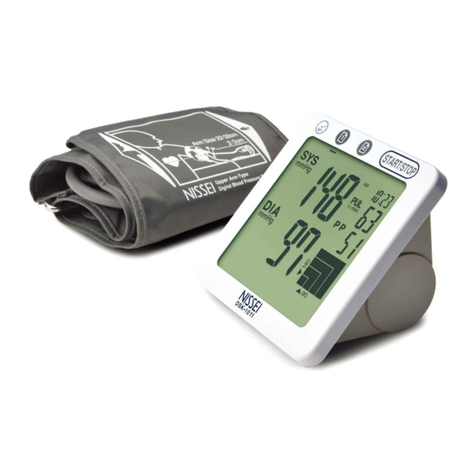
Nissei
Nissei DSK-1011 User manual
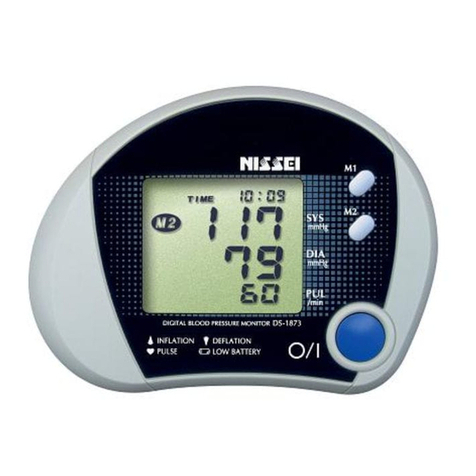
Nissei
Nissei DS-1873 User manual

Nissei
Nissei WS-820 User manual
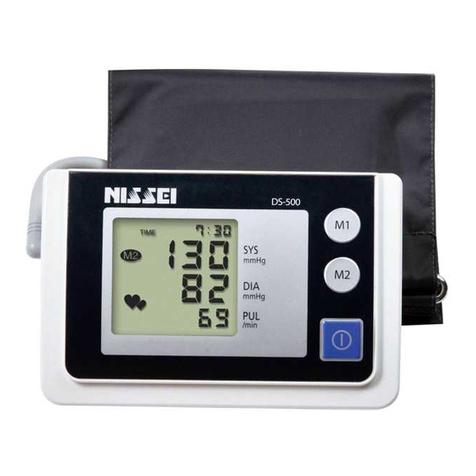
Nissei
Nissei DS-500 User manual

Nissei
Nissei DSK-1031 User manual

Nissei
Nissei WS-1300 User manual
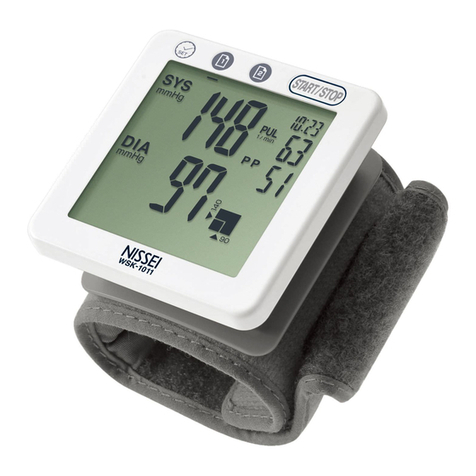
Nissei
Nissei WSK-1011 User manual

Nissei
Nissei DSK-1031 User manual
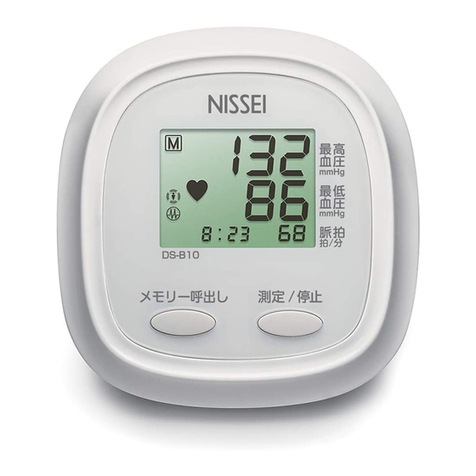
Nissei
Nissei DS-B10 User manual
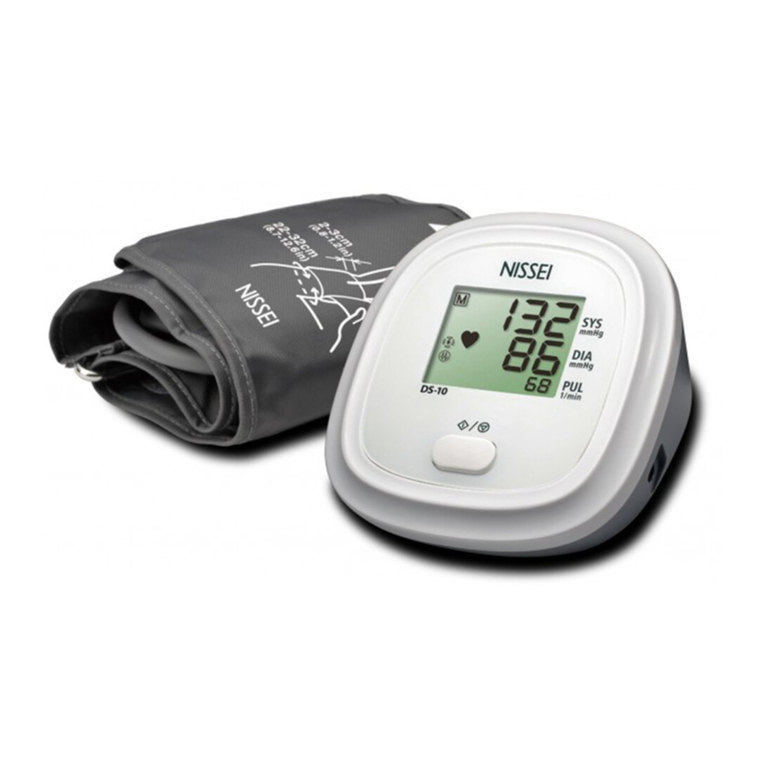
Nissei
Nissei DS-10 User manual

Nissei
Nissei DS-137 User manual
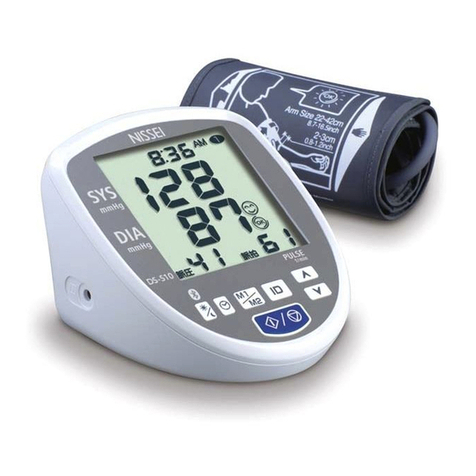
Nissei
Nissei DS-S10 User manual

Nissei
Nissei WS-820 User manual

Nissei
Nissei DS-400 User manual
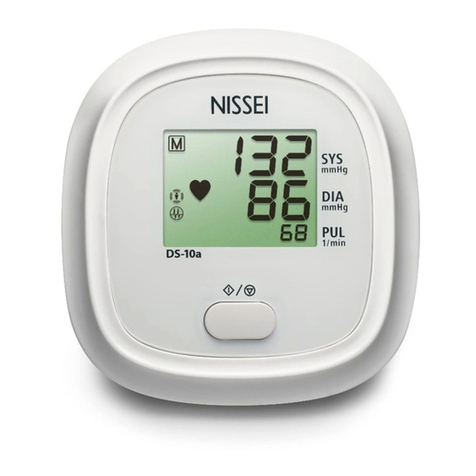
Nissei
Nissei DS-10a User manual
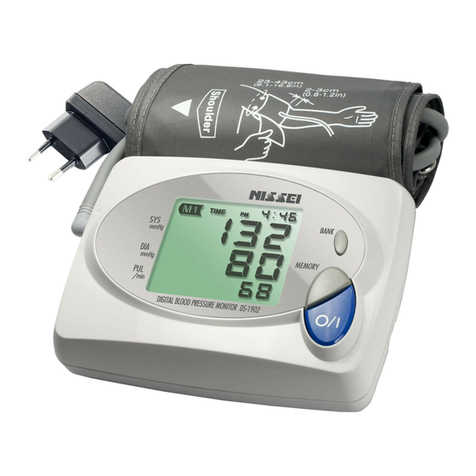
Nissei
Nissei ds-1902 User manual

Nissei
Nissei WSK-1011 User manual

Nissei
Nissei DSK-1011 User manual
